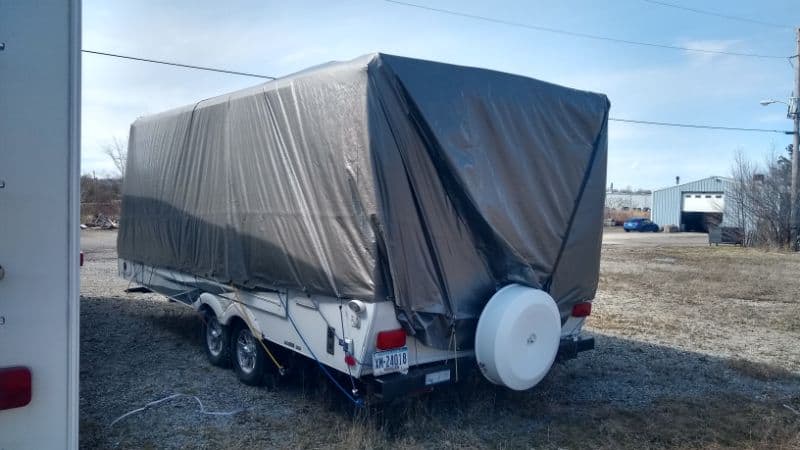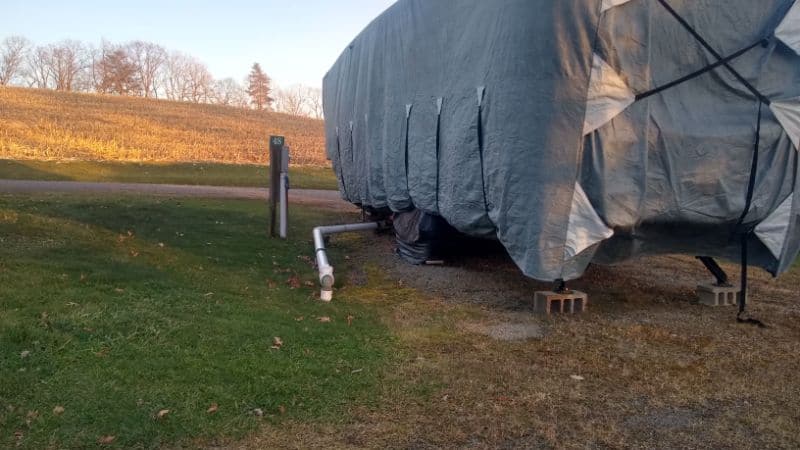We’ve all been tempted. Why shell out the $1,000 for a pre-fitted cover? Or the $3,500 for an RV carport and parking pad? What’s wrong with the $100 tarp at Walmart? Why should you spend more money on a glorified hoodie for your RV than on your kids and grandkids at Christmas?
Should you put a tarp over your RV? As a rule, no. Tarps trap moisture. Loose tarps and bungee cords can cause major damage. Better ways to cover your RV include pre-fitted covers and RV carports.
So no, don’t rely on a tarp to protect your RV. Unless, of course, a tree fell on your roof and it’s raining. In that case, use a tarp – use anything – to cover up that roof ASAP!
Or if you’re about to get two feet of snow … (but more on that later)
Food Chain of RV Storage
So, just how bad is covering your RV with a tarp?
To help you out, I devised a hierarchy of RV storage options. Let’s start from the top with the best:
- Indoor climate-controlled facility with a monitored security system
- Indoor garage, no climate control
- Parked parking pad with RV carport or lean-to cover
- Shrinkwrapped
- Gravel parking lot
- Hidden in the backyard
- Covered with a tarp
- Parked beneath a tree full of birds, in direct sunlight, in a thunderstorm – and covered with a tarp.
5 Reasons Why to NOT Tarp Your RV

1. Tarps Trap Moisture
Unlike an RV cover, which is breathable, tarps don’t allow moisture to pass through. Water that gets beneath, stays beneath.
Water can enter beneath a tarp in three ways:
- Leaks in the tarp
- Condensation from humid air
- Driven by rainstorms
Condensation & Humidity
Condensation is particularly insidious. Warm, humid air migrates under the tarp during the daytime. At night, the air cools, and the humidity condensates as liquid water. The next day, the cycle repeats. And drop by drop, gallons of water can potentially collect underneath the tarp.
Another source of moisture is from within your RV. Many RVs have attic vents to dry out the RV attic (aka roof assembly). When covered by a tarp, those attic vents can’t properly do their job, and the ceiling of your RV stays damp.
To make things worse, because tarps are usually dark-colored, they increase heat gain – which causes even more vapor drive.
Even if you don’t get ponding water beneath a tarp, you still normally must contend with a super-humid environment. This is particularly a problem in the southeast, Mid-Atlantic and Midwest. A warm, humid environment breeds mold and mildew, which can damage roofing sealants and roofing membranes.
Obviously, you won’t get ponding water or mildew after a day or two. Tarping your RV for a weekend won’t ruin your roof. But leaving a tarp atop your rig for weeks or months or end, especially during the transitional spring and autumn seasons, is not a good idea.
Snow & Ice
If you live anywhere close to the 45th parallel, you’re familiar with the white stuff. And it’s not kind to RVs. So what’s worse: Leave your RV outside to freeze-thaw-freeze all winter, or cover it with a tarp?
As you probably know, most RVs aren’t designed for heavy snow loads. (If you’re looking for 4-season RVs, check out manufacturers in the Pacific Northwest). There’s no doubt that a cover helps shed snow and break up ice before it becomes a major problem.
So I get it – you don’t want Old Man Winter to dogpile your RV with two feet of snow. And at the risk of beating a dead horse, that’s why you should have an actual RV cover! But if you don’t have one and insist on using a tarp… well, honestly, pick your poison.
2. Tarps Look Trashy

Let’s be honest: RV tarps look trashy. They make you look like a moonshiner with 11 kids and a brother named Bubba. And they are usually held down with bungee cords or ratchet straps. These don’t improve the curb appeal, sadly.
It’s one thing to tarp your personal RV parked in your backyard. It’s another thing to cover your RV with a blue poly tarp and travel across the country. And it’s extremely poor etiquette to tarp your RV while camping, especially if you’re camping long-term. Nothing ruins a campground’s first impression like a faded blue or brown tarp flapping around a beige stick n’ tin travel trailer.
3. Tarps Break Down
Cheap tarps aren’t designed for 24/7 exposure to the elements. They fade, tear and rip. Sunbaked tarps can shred as easily as wet paper. RV covers typically don’t break down as quickly.
4. Tarping Damages
RV dealerships will tell you that tarp damage is a huuuuge cause of complaints. I’ve seen this myself. Or a similar problem: I’ve seen a bit of vinyl screw cover trim come loose on the highway, and within 100 miles, the loose end has cracked an acrylic window, battered decals, and splintered the fiberglass sidewall.
Unless you meticulously tension every inch of your tarp, chances are you’ll have a loose corner or a flapping edge. Or a loose bungee cord. Anything loose can flap in the wind. Fiberglass RV walls and roofing membranes, like EPDM, are particularly susceptible to damage from abrasion. You’ll get pin holes in EPDM and grayed-out splotches on gelcoat.
5. Tarps Are Awkward

Have you ever tried to tarp an RV? It’s awful. Unless you have an extremely small camper, you need to use two or three tarps to cover the whole thing. It’s the world’s worst jigsaw puzzle. You’ll the whole day ratcheting straps, padding sharp edges, patching ripped grommets, stuffing tarps into wheel wells, and muttering a slow, steady stream of curse words. It’s a good way to ruin a weekend.
Plus, because tarps aren’t fitted, you can run into fitment problems. A classic problem is ponding rainwater that causes an RV to sag and – you guessed it – collect more water! It doesn’t take long before your tarp is holding 30 gallons (aka 250 lbs) of rainwater. Just imagine the damage that can do!
RV-specific covers have zippers and vents to allow access to your RV, even when it’s covered. That way, you can maintain and enter your RV in the off-season (aka, check for mouse infestations!) Tarps don’t have any of those features. And believe me, you don’t want to install a tarp or cover more than once a year!
What’s Better: A Tarp or Nothing?

We can all agree that a storage option higher up the food chain is the better solution. But for the sake of this article, let’s assume they aren’t an option.
So what’s better: A blue tarp or nothing at all?
Personally, I am of the opinion that nothing at all (usually) beats a blue tarp.
Again, I would never blame someone for temporarily tarping an RV to stop a roof leak. But get that RV fixed ASAP! Otherwise, leave your RV in the elements.
“But what about all the bird poop and dust and acid rain and peeling sealant?” you ask.
Good point. You’ll have to manually maintain your roof: Inspect your roof seals every 90 days, reseal self-leveling and lap sealants where necessary, wash off bird droppings, scrape off tree sap, clean leaves out from your A/C shroud, and wax/re-coat as necessary.
Yup, it’s a lot of work. Hence why the correct cover is recommended. But more times than not, a blue tarp is a case where the cure is worse than the disease.
Everglade Vultures: the Only Acceptable Use for a Tarp!
But if you do insist on using a tarp … get a big one. Get a thick one. Get the biggest, thickest tarp you can find, at least 10 mil thick.
- Pad all edges and corners. (Hint: Pool noodles and tennis balls are your friends.)
- Lash the tarp tight. Then lash it again.
- Cover the wheels.
- Check it every week.
- Cross your fingers.
Sometimes, you’re out of options. Here’s a story: In the Everglades, vultures have taken a liking to the rubber trim around automobiles: windshield wipers, door trim, sunroofs, etc. When you park at Royal Palm parking lot for a stroll down the Anhinga trail, you’ll be warned to cover your car or RV with a tarp to keep the vultures at bay! Tarps and bungee cords are provided. Ladders aren’t. I watched one poor soul struggle with a 12×16 tarp over a 36-ft motorhome fighting over five vultures. “Bad day,” I mused, and wondered off to watch the alligators.
So if you find yourself fending off rubber-ravenous vultures in southern Florida, I encourage you to tarp your RV. Otherwise, get a real RV cover!

Leave a Reply